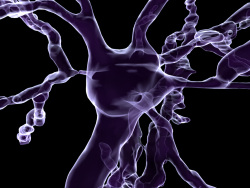Mission and Vision
Leonardo da Vinci referred to his studies of anatomy as "cosmografia del minor mondo," a "cosmography of the microcosm." We propose to carry the exploration of this world within to finer grain, to a cellular level of detail.
Mission
The mission of the Brain Networks Laboratory is to develop innovative methods for submicron-scale sectioning, imaging, and analysis of brain tissue volumes. Through these activities, we aim at gaining new insights into the functional principles governing the natural computations employed in the operation of the brain.

3D reconstruction of Golgi data: Golgi-stained neuron is reconstructed in 3D. [More images] [More nuggets] |
Vision
Impacts on computational neuroscience and information technology
Our research on mouse brain networks has the potential to transform the way we think about computation. Network function is built on architecture, both connectivity and neuron morphology, and it is the architecture of the mouse brain, as a template for all mammalian brains, that constitutes the subject of our investigation. The mammalian cerebral cortex, a modular cognitive machine wonderfully adapted for natural computation, is both parallel and distributed in structure.
In the long term, findings from our research will lead to a theory of parallel and distributed information processing that bridges both computer and brain networks. Such brain network models could help greatly in building the next generation of IT infrastructure: one less brittle, better adapted to providing relevant and timely information, and better able to model and interact with its environment.




